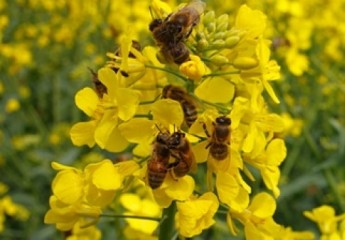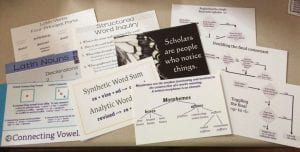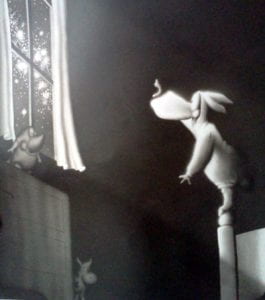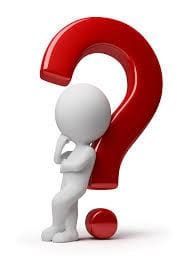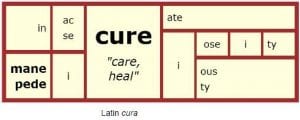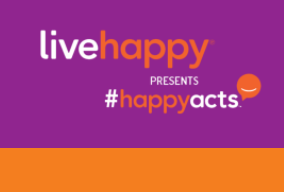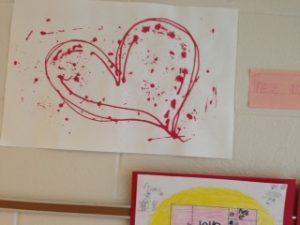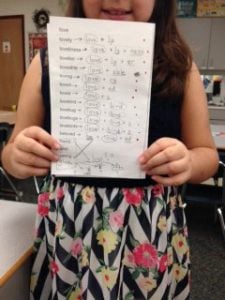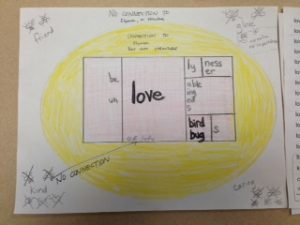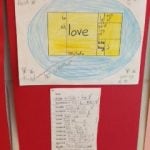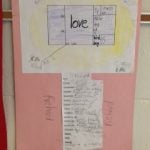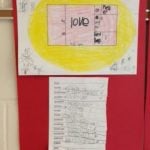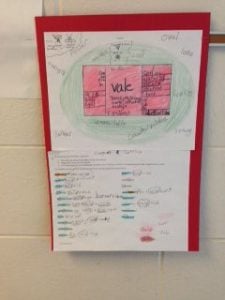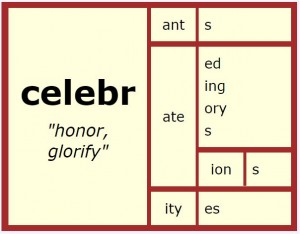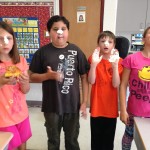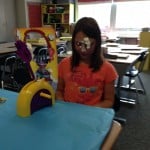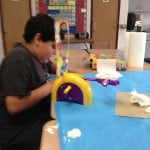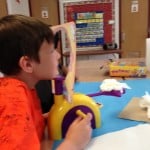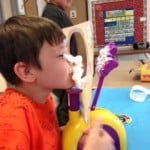Today was an historical day in the world of working together as a group and as learners who are generally challenged by the English language. Today, the students broke out of the shell that has encapsulated them most of their lives through searching for meaning and structure of a word and by helping each other reason out a word sum with NO teacher prompting, guided questioning or leading. This moment was so rich and so profound, I had to take a breath in to hold back a tear or two from escaping my gleeful, smiling eyes.
We started the lesson by looking at a Social Studies chapter from their General Education classroom — quite happily, I am able to support their reading, spelling, & writing by doing SWI (Structured Word Inquiry) with concepts and vocabulary from their GE curriculum. I asked what they needed to understand deeper/better about the chapter on Native Americans. They said they were not able to tell what the words in red ink meant (vocabulary words). We made a list: origin stories, migration route, environments, & adapt.
We looked at the first term in parts: first we tackled <stories>. I wrote this word on the board and asked the students to analyze it as we did last school year (without guidance which would help me determine how much review would be required and plan future lessons). When the group grew quiet with uncertainty, I encouraged them to hypothesize the structure of this word — reminding them that a hypothesis allows us to think and not worry about correctness — we would test out each theory, we would find evidence to determine which hypothesis is right or wrong and we always learn from both of those experiences.
Within a few seconds, downcast eyes began to lift to the board and I could see their minds shift gears. A few still met with trepidation while still a few others raised their hands to give it a try.
Here’s what was suggested from <stories>:
- Student #1 said: <stor> + <ies>
- Student #2 said: <store> + <s>
- Student #3 said: <story/(i)> + <es> “s-t-o-r-y, change y to i; plus es”
It is here that the real learning began when St #2 declared, “OH!! I see what I forgot! My word sum needs to be <store + …….i? no….I forgot the <i> but….hmmm” and he trailed off, clearly recognizing that he knew he was forgetting something but couldn’t make it fit his word sum. Then St #3 said, “I think mine’s right ‘cuz I remember, ‘change y to i when you add <es>'”. Student #2 defended his use of <store> and St #1 quickly reminded him that <store> is pronounced /stor/ not /story/. Another student chimed in to say that <store> is a place you buy things from and the collective agreement from the group was audible, “Oh yeah!” which came loudest from St #2.
From here, much discussion ensued among the majority of kids who were present. The quietest kids were the 2 who are new to our group this year. There was a wonderful debate, very mature, no demanding tones or indignation; simply discussion of meaning and suffixes and spelling conventions. All the while, I stood there, biting my lip to stop myself from interjecting to provide clarity, guide or lead. The students did not need me to interrupt their remembering of past lessons or the processing of the 2 words before them. While they discussed and debated, the one thing that rang clear for me as I simply watched and took this moment in, was that they were all around the evidence but no one was confident in declaring why their word sum worked or did not work, even St #3 who appeared to understand the relationship between <stories> and <story> and who’d rattled off the spelling convention with ease or the others who agreed with this convention. Some of the students were not convinced that <store> and <story> were not the same (a few forget that <e> is silent at the end).
After I shared my absolute joy with the group at their stellar debate, I drew a picture on the board –the rectangle barely surfaced before someone blurted out that I was drawing a store and our word is stories, they do not mean the same thing! And yet, still the connection was not quite solidified in their minds (quizzical looks on their faces told the story!). So I asked them, “What are stories?; Are they buildings where you can buy things?” Answers drew us to the conclusion that stories are the plural form of story and a story is something you can tell or write that tells about something. Once the students saw the connection to the singular form <story> they were confident they were on the right meaning track and their use of the spelling convention of changing <y> to <i> was applicable.
We then looked at the hypotheses on the board and began to reason out their accuracy with the evidence we had come up with: <story> as the base word; spelling convention of changing <y> to <i> when adding a vowel suffix (more to this convention at a later date). We reasoned we had no evidence, past or present, for an <-ies> suffix and that <stor> was not a bound or free base element. We recognized that <store> + <s> would give us the plural form of <stores> where we buy things. In conclusion, St #3’s hypothesis made sense in its structure and meaning.
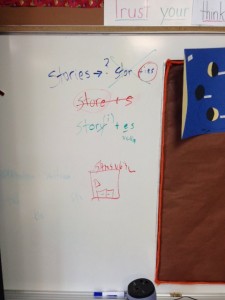
As a group we celebrated this moment of connection, meaning, and mountain of evidence we’d collected. The next little gem of knowledge was about to be unveiled — not given, but unveiled through thinking, linking it to SS, and physically clipping off a piece of paper …. the students eventually recognized that the word <story> is a clip of the word <history>!
A lot of time had gone by and we hadn’t even gotten to complete the first vocabulary word! No fear, no worries, only smiles and a sigh of awesomeness; I know these students gained more from these last 20 minutes than they would have had we read the terms from their book with the definition and tried to memorize them (besides, they’d already tried it that way and were here, asking for help with these terms!).
So, onto the first part of this term, <origin>: a quick look at Etymonline revealed the denotation of the Latin nominative root origo “a beginning, a start, source, descent, lineage, birth”; putting these two words together, gave the students a deeper sense of what their text book meant by Native American origin stories. These would be stories that reveal the history of this culture, from the beginning of its time, not their current culture or stories. The students’ tone and gestures told me all I needed to know– they understood with deeper meaning — how do I know? I saw it in their exuberant smiles, heard their cheer, watched them lift their arms in victory — that’s as real as it gets!
We had minutes to spare before the end of the session, so we tackled <migration> our hypotheses came at rapid speed, the discussion and debate even faster.
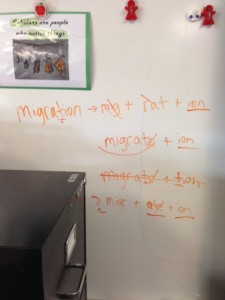
We quickly ascertained that 2 of the hypothesese were not even going to be up for consideration — as one student loudly proclaimed, “<-tion> can’t be a suffix — remember the video from last year?!?! We proved it!” I couldn’t resist pointing out that the there would have to be 2 <t>’s in <migration> if we had one at the end of the base and one at the beginning of the suffix as well — hey, the more the evidence ithe better, right?! Before we ended the session (Mrs. B’s stomach was growling, it was lunchtime for me!) we all felt very comfortable with <migrate> as a base with <ion> as the suffix. Tomorrow, we will begin testing our final hypothesis that <migr> is a bound base by looking at Etymonline and the Word Searcher.
Take a moment to notice the poster hanging in the picture above, it is of a caterpillar’s journey to becoming a butterfly with a quote from Real Spelling’s Michel, that says, “Scholars are people who notice things“. The poster was inspired by Mary Beth Steven, a teacher in Wisconsin who blogs about her class’ SWI learnings, she made a big poster of this quote for her classroom and shared it with our SWI community. I found it too valuable not to copy! When kids notice things that build on their learning or solidify a concept or denounce a theory, it’s worth pointing out to them. It makes them stronger learners, more aware of what makes sense and in turn, builds their confidence.
I am excited to continue noticing these little scholars’ learning this year!
